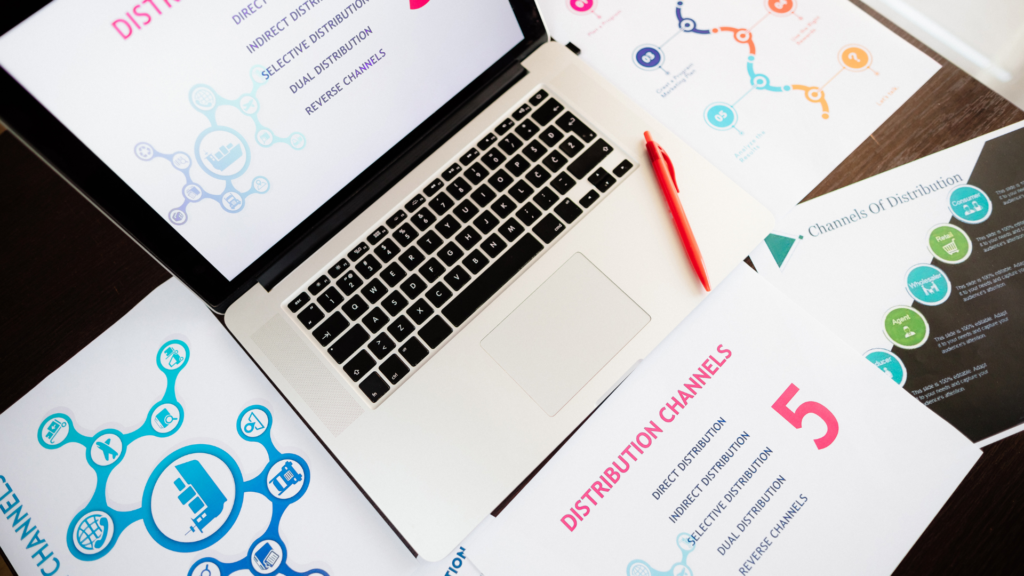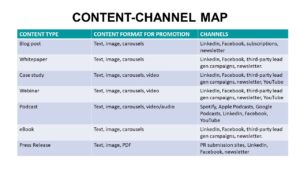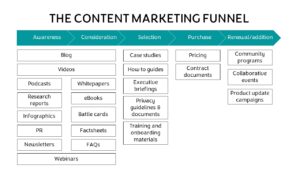Content Distribution 101 – Find The Perfect Mix Of Marketing Channels

This article was originally published in the Elevate Your Marketing newsletter and has been repurposed and republished here with the author’s permission. Here is the link to the original article.
Content distribution is as important as (if not more important than) content creation. But, there are many thoughts flying around when it comes to picking the right marketing channels to distribute and promote content.
But the fact is, there is no ‘one size fits all’ approach to this. Every business is different. Every industry is different. So, in this article, we will look at a step-by-step process for finding the right blend of marketing channels for your business rather than attempting to list down the ‘best channels’.
Before we start with the content distribution strategy
First, we all need to understand two things:
- No strategy is rigid. So is a content distribution strategy. You have to continuously experiment, learn, and adapt.
- As time changes, the effectiveness of marketing channels also changes. What works today might not work tomorrow.
Keeping these in mind, let us look at the 9-step framework to finding the ‘super mix’ of marketing channels for your business.
How do you develop an effective content distribution strategy ? The 9-step framework
According to me, there are 9 essential steps to content distribution when it comes to picking the right channels:
- Goal definition
- Audience analysis
- Channel benchmarking
- Competitive analysis
- Balancing demand gen and demand capture
- Content-channel alignment
- Setting a distribution frequency
- Designing your content marketing funnel
- Preparing the content distribution calendar
Let us look at each of these in detail.
1. Goal definition
This is fairly simple. You need to know what you are promoting content for. Is your goal generating leads? Is it about improving brand awareness? Or is it about establishing yourself as a thought leader in your space?
Your goal need not always be one-dimensional. It can be a combination of two or more. Whatever it is, you need to have a goal to work towards. However, it is important to note that this goal has to be purpose-driven and the aim should be to keep progressing every single day.
For instance, if your goal is to improve the visibility of your company’s brand, there is nothing like the end state where you become the ‘best brand’. You always need to keep working towards making your brand better.
How can you balance multiple content distribution goals?
Balancing multiple content distribution goals is all about finding the right channels for the right goals. While some channels are good for improving awareness, some are very performance-driven and can give quick results.
For example, if you already have a good email list, shooting an email is a great way to get some eyeballs on your content. On the other hand, organic social media marketing is more of a long-term approach which is more focused on building a brand.
2. Audience analysis
Once you are clear on your goals of promoting content, you are ready to move to the next step – which is audience analysis. This is nothing but understanding where your ideal customers hang out, and using that information to reach them where they want and when they want.
Following are some techniques using which you can understand your prospects’ marketing channel of choice (assuming you clearly know your ICP):
- Customer interviews and surveys.
- Analyzing social media profiles and platforms.
- Using a market research aggregator tool (e.g. SparkToro).
- Finding active communities (online and offline) in your prospects’ niche.
- Identifying events (online and offline) they take part in.
Once you identify the platforms your prospects are active in, you can dive a little deeper to see:
- What are the types of content they are consuming?
- What time of the day or week are they the most active on these platforms?
- What are the different ways in which you can distribute content on the platforms (say video, live events, carousels, etc.)
3. Channel benchmarking
This step involves understanding how various channels are currently working for your business. You can get this data from Google Analytics, your marketing automation tool, and attribution software.
Here is what you need to look for:
- How much revenue, pipeline (average deal size, aggregated deal value), and leads (MQLs, SQLs, SALs) each channel is bringing (please refer Why B2B Revenue Attribution Is Broken And How to Fix It to learn how to effectively implement revenue and lead attribution)?
- Which channels are influencing deal conversions the most?
- What channels are bringing the most amount of traffic?
- How much money you are putting into each channel and what is the channel ROI?
The objective of this step is to double down on channels that are working the best for your business.
4. Competitive analysis
This doesn’t need an explanation. You can use the following techniques to see what channels your competitors are using:
- Traffic and SEO analysis (use tools like Similarweb and Ahrefs),
- Social profile analysis (LinkedIn, Facebook, YouTube, etc.).
- PPC ads analysis (using tools like Adbeat, Moat, or social platforms themselves).
- Subscriptions analysis (blog subscription, newsletters)
- Demand gen channels analysis (such as podcasting, organic social, events, PR, etc.).
Analyzing what your competitors are doing across these types of channels will help finetune your content distribution strategy.
For comprehensive guidance on competitor analysis refer to this article.
5. Balancing demand gen and demand capture for content distribution
Many marketers – even some of the most advanced ones – tend to focus only on demand capture channels such as SEO, paid ads, email marketing, LinkedIn outreach, etc. But at times they ignore demand generation channels such as organic social, podcasting & podcast ads, events, video marketing, etc. (please note that some of these channels – such as email marketing – can be used for both demand gen and demand capture).
However, for long-term marketing success, you need to find a balance between the two. There is no magic formula as to how much of your budget should be allocated to each. You need to keep testing them and figure it out over time. However, for a start, you can follow the 70/30 rule where you can invest 70% of your resources in demand capture and the rest in demand gen.
Also read: 35+ B2B Demand Generation Trends For 2024 And Beyond.
6. Content-channel alignment – choosing the right content distribution platforms
Not every type of content is made for every channel. There can be content formats that work particularly well in certain channels (for instance, polls tend to get more reach on LinkedIn). So you need to create a plan when it comes to the choice of channels for a given type or format of content.
The best way to do it would be to create a content-channel map where you list down all the channels where a content type can be promoted. This map will also help you visualize what content format is required to promote a specific type of content.
A sample content-channel map is given below (please note that this is only a sample and not a comprehensive content-channel map):

At the end of this mapping process, you should be able to clearly lay out which channels to use to promote every type of content.
7. Setting a distribution frequency
The distribution frequency varies across channels and campaigns. And as trivial as it may sound, knowing the ‘right’ frequency for every channel can make a huge difference.
To understand this better, here are a few examples of distribution frequency:
- Email/LinkedIn newsletter: Once a week or fortnight.
- Organic social: 5 to 10 posts per week.
- Videos: 4 to 5 per month.
- Blog posts: 1 to 2 per week.
- Podcasts: 1 episode per week or fortnight.
When you prepare your content distribution calendar (as given in step #9), it is necessary to take frequency into consideration and plan campaigns in such a way that you neither overutilize nor underutilize any channel.
8. Designing your content marketing funnel
A content distribution strategy is never complete without understanding the content marketing funnel. A content marketing funnel refers to aligning various content types along the different stages of the customer journey.
A sample content marketing funnel for a B2B SaaS company is given below:

Now, why is this step important with respect to picking the right marketing channels for content promotion?
It is because this step ties back to step #1 – which is establishing the goal of your content distribution efforts. Here, you choose the types of content that work for each stage of the customer/buying journey.
In fact, when you prepare the content-channel map (as explained in step #6), you need to consider the stages of the customer journey (now you can see how multiple steps in this framework are intertwined. Almost no step can work in isolation).
9. Preparing the content distribution calendar
The final step in finding the right set of marketing channels to promote your content is to create a Content Distribution Calendar.
Here is a sample content distribution calendar for your reference. Please remember that this is only a sample and you need to adapt the calendar based on your business scenario. As mentioned at the beginning of this article, you need to be flexible enough to change and adapt as you conduct more experiments with marketing channels. A best practice is to diversify your channels so that there is no excessive dependency on one.
How can you refine your content distribution strategy?
As I mentioned earlier, no strategy is rigid. It applies to content distribution as well. The primary step to refining your content distribution strategy is going back to the 9-step framework. A best practice is to relook at your goals and how the buying behavior of your ideal customers has changed every quarter. However, this might be an overkill for some industries. Doing this exercise every 6 months is enough in most cases.
Which distribution channels allow you the most control over your content?
This is one of the most common questions asked when it comes to crafting a content distribution strategy. This is where the concept called earned media becomes relevant.
Earned media refers to all those channels that you have the most control over. Examples include your website, blog, podcasts, email campaigns, your online community, etc. These are the best places for you to have complete control over the content you create.
Skalegrow – a new-age content distribution company
With marketing getting tougher and tougher, every wrong foot you make might hamper your growth. What you need is the right guidance and a helping hand. This is where Skalegrow can make a sea of difference.
Skalegrow helps IT, tech, SaaS, and embedded systems companies leverage new-age marketing tactics to grow their business. From creating an end to end content distribution strategy to building a customer-focused content repository, we can help you with everything content.
Check out the below intro video to learn more about what Skalegrow brings to the table:
Alternatively, you can visit our services page or write to us at info@skalegrow.com.
About the author

Naseef KPO is the Founder and CEO of Skalegrow. He comes with rich experience across multiple areas of B2B marketing including content marketing, demand generation, SEO, account-based marketing, marketing analytics, revenue attribution, marketing technology, etc. He writes thought-provoking and relevant articles on The Skalegrow Blog and his weekly LinkedIn newsletter Elevate Your Marketing.
Prior to starting Skalegrow, Naseef led large marketing teams in multi-million dollar B2B organizations where he made significant contributions to the topline growth of the business. He has also appeared on numerous podcasts where he shared his thoughts on trending marketing topics such as the application of AI in marketing, startup marketing, ABM, and B2B content marketing, just to name a few. Being the founder of Skalegrow, he is currently focusing on helping its clients stay ahead of their competition by using innovative yet practical marketing tactics.
You can connect with Naseef KPO on LinkedIn.

John Doe
Habitant morbi tristique senectus et netus et malesuada fames ac turpis egestas. Nullam vehicula eros in suscipit fringilla. Aenean quis ex hendrerit, fringilla diam egestas, hendrerit nunc. Nunc at egestas magna. Nullam eu tempus ipsum. Pellentesque arcu mi, condimentum sit amet tincidunt eget, tristique sed turpis. Cras tempor mollis ultrices.






![How To Craft A Cold Email Sequence That Works [With Examples]](https://skalegrow.com/wp-content/uploads/2024/12/How-To-Craft-A-Cold-Email-Sequence-1024x576.png)


 your marketing
your marketing  new-age tactics?
new-age tactics?